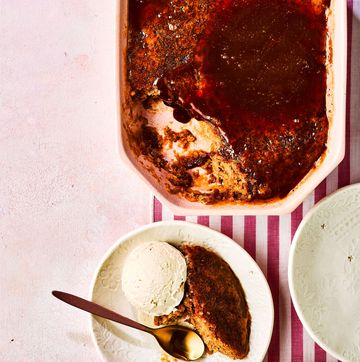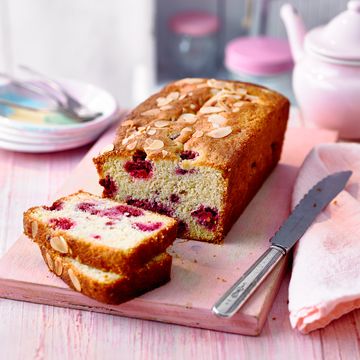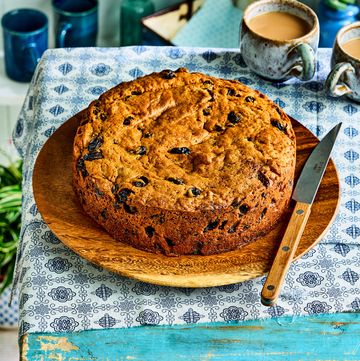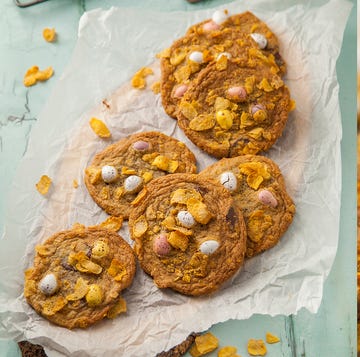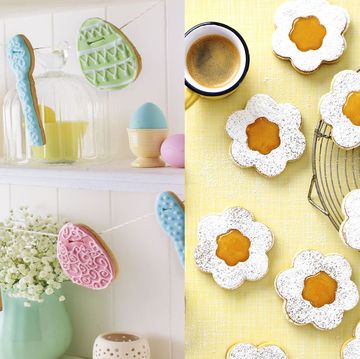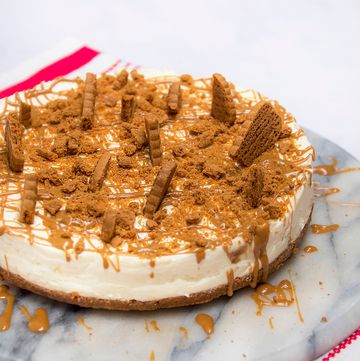One of my earliest food memories is pressing my nose to the glass of the cabinet at a local American-style cookie shop, drawn in by the unmistakable sugary scent wafting from the ovens used to bake them fresh. A totally different beast to a UK biscuit, their combination of crisp edge and squidgy interior was unlike anything I’d eaten before.
Once I was old enough to have the run of the kitchen, I became obsessed with trying to work out how to make my own, with absolutely no success (this was back before recipes were a few internet clicks away – the cookery books and magazines I used didn’t get it right). Years later, I revisited the challenge at work when I was tasked with creating a perfect chocolate chip cookie recipe for a magazine feature. A few co-workers kindly foisted their favourite recipes upon me but, sadly, none hit the spot, so I started from scratch, got scientific and learned a lot in the process.
All in all, I’ve calculated that I’ve baked upwards of 700 chocolate chip cookies – partly in pursuit of perfection, but also for many, many bake sales. The hunt for a foolproof recipe has meant I’ve tested countless versions and analysed what it takes to make that very sought-after thing: a chocolate chip cookie that’s crisp and a little chewy on the outside and meltingly gooey on the inside.
In all that time, I’ve made mistakes: overcooked them, undercooked them, tried recipes where the cookies spread so far they all joined together to make one giant rectangle on a baking tray (not as great as it sounds); cookies that were disappointingly cakey; ones that burned around the edge but were still inexplicably raw in the centre. To paraphrase Thomas Edison, I did not fail – I simply found multiple ways that didn’t work, and it ultimately led to me learning many tricks. Rather than you having to encounter similar pitfalls, here’s everything I’ve discovered along the way, along with how to get the kind of cookie your heart desires, just by making a few simple tweaks.
A cookie recipe begins with butter
The foundation for my ideal cookie? It’s the same answer I give to most of life’s questions, which is: butter. Butter is king. Why? No other fat has the same flavour, and that’s down to the milk solids that it uniquely contains. Make a cookie with oil, try to serve it to me and I will immediately detect and (probably) reject it. The texture might be pleasant, but I can guarantee it will lack flavour and depth.
But which butter? Does it need to be a fancy French one? Non. All that’s truly required is unsalted butter. I like it because I want precise control over the saltiness. By all means use salted, but remember that the salinity varies WILDLY from brand to brand. I always add salt to the cookie dough, but I prefer the predictability that measuring it out gives me, and the flexibility to then scatter flaky sea salt on at the end, if I wish.
To melt or not melt butter? This is a personal preference. For me, melted butter is the key to achieving that holy grail of crisp outer/tender inner. Every cookie I’ve tried to make using solid butter creamed with sugar has a cakier texture from the air that’s incorporated, been somewhat of a spreader and not chewy enough. Use this technique and, as the butter melts, you’ll see it takes the rest of the ingredients with it and you end up with much flatter cookies. Melting the butter first means that the cookies hold their shape in the oven, stay thicker and have that signature close biscuity crumb.
A note on brown butter: I’ve compared browning the butter vs not browning the butter using the same recipe and I’m here to tell you that I couldn’t taste the difference at all (the butter browns during the baking anyway). I’m convinced that people laud it as magical because of the fact that it’s melted butter rather than creamed, and it produces a superior result for that reason alone. However, having said that, senior cookery writer Alice's Chunky Brown Butter Granola Cookies are amazing, so maybe there are some exceptions!
Cookies need a mixture of sugars
One of the things I got wrong time and time again? The sugar. You’d think that those pleasingly blonde cookie doughs were made with just white sugar, but you’d be wrong. The cookies that I fell in love with? I now realise there must have been brown sugar in those bad boys. It might not have been visible, but it was quietly present and using some is part of the secret to cookie success. The molasses in brown sugar not only gives it a more three-dimensional flavour than white sugar alone, but it also contributes to a softer interior. You can’t use brown sugar by itself, though. You need white sugar for crispness and chew, too (and granulated seemingly works better than caster sugar). Use more brown sugar than white and it’s a cakier cookie, so I prefer to use a higher proportion of granulated white sugar.
The flour you use makes – or cakes – a cookie
But what about the flour? I’ve tried making cookies with plain flour, self-raising flour and bread flour and have concluded that plain flour wins hands-down – it contains just the right level of gluten and affords more freedom to be precise with the raising agents (can you see the pattern here?). Strong flour has too much gluten, giving the kind of disappointingly leaden cookie that I’ve come across at overpriced farmer’s markets. Self-raising flour just turns your cookie into sponge, and that’s not what I’m looking for. Also, if you like your cookies crisp, be wary of recipes with high amounts of flour, as they tend towards the soft-bake side. The more flour in your recipe, the thicker and softer your cookies will be. Drop it down too much, though, and the cookies will spread a lot and the crumb will be snappier and brittle.
Although you only use a small amount, raising agents play a big role
My first attempts at cookie-making used baking powder (and far too much of it), and what sprung forth from the oven was always the same: thin circles of uniformly fluffy, airy, cakey nonsense. What I’m after is a close-structured bake that’s a bit biscuity around the edge, and a small amount of bicarbonate of soda seems to understand this assignment.
Chocolate: size matters
It’s worth giving thought to the chocolate you use. I’m not talking about dark, milk or white here – that’s your personal preference. What I mean is the format. Chips are very convenient (great if you’re a caterer or time-pressed office bake-off baker), but they’re small and regular, so you don’t end up with glossy puddles of chocolate in your cookie. I prefer cutting up whole bars to achieve this.
However, large pieces alone mean that you don’t always get a bit of chocolate in each bite, so my compromise is to roughly chop the bar into an irregular mix of larger chunks, smaller chips and plenty of fine flakes, then stir it in, making sure there are some large chunks on top after shaping (this means the chocolate is visible at the end, too). It’s the best of both worlds.
You need more vanilla than you think
It’s an expensive ingredient, but when it comes to cookies, too little vanilla extract makes for a bland bake, or allows notes of egginess to come through. Don’t skimp on the stuff, and try to buy the best quality bottle you can afford.
Eggs are eggs?
I’ve tried recipes where extra yolks are added (purported to give an extra-gooey centre) and the most noticeable difference is that these cookies are slightly puffier. Instead, I’ve found that fudgy middle just appears when the proportions of all the ingredients are right. Extra yolk is not essential to the process.
To chill cookie dough or not to chill
There’s conflicting advice out there about resting/chilling cookie dough. Some chefs say it’s necessary; I’ve found it’s less about the notion of ‘resting’ and more about allowing the dough to set until it’s firm enough to completely hold its shape, so you don’t end up with thin cookies. This can take anywhere from 20min to an hour, depending on the recipe.
Cookie dough: size matters (again)
The smaller a cookie is, the more uniform its texture will be, because the entire dough ball will melt at once, heat through and cook evenly from edge to middle. If you use a larger piece of dough, while the outside of the mixture is melting and cooking, the inside will be colder and uncooked, which means, by the end of the baking time, the edges will be crisper and the centre will still be a little softer. Not flattening the dough also helps this, so shape it into a rough ball rather than a thin disc.
Portion control is essential if you want your cookies to all be the same size
You don’t need one of those fancy dough scoops that food bloggers all love, either. Just weigh your finished dough, divide the amount by the number of cookies you want, then pinch off pieces to that weight. Don’t roll the balls too much – it hides all the chocolate inside. Keeping them rougher will make them more visually appealing.
Get your baking tray prep correct
Grab the largest, sturdiest baking trays you have. Always line them with non-stick paper and space your cookies as far apart as you can – it’s better to bake smaller batches than try to cram too many on a tray, as they’ll join together.
How to make crinkly cookies
The fashion for crinkly cookies has been one driven by social media. Is it indicative of a better cookie? I wouldn’t say so. Generally, the recipes with less flour bake flatter and have more cracks. Making the balls of dough bigger also contributes, as this allows the dough to fold over itself as it melts and cooks. The final method is a convoluted process of removing the tray from the oven a few times during baking and dropping it on to a hard surface, which – to me – seems a little more effort than it’s worth.
Timing is crucial
Too long in the oven and they’ll crisp too much. Too short and they might be a bit raw. One of the major mistakes I used to make was thinking that because cookies still felt soft when pressed, they were undercooked. Not true – they will still feel a little squidgy, but as long as the surface isn’t sticky and they look cooked, they are. You can wait until the edges are golden if you must, but if the middle browns and the edges feel solid when you test them, they’re most likely overbaked. Timings can vary from oven to oven and recipe to recipe, so you might need a bit of trial and error. Always plump for the shortest amount of time in the recipe and assess from that point if they’re done or whether they need a bit longer. Nerdily, I’ve tested baking the same cookie dough into large and small cookies, cooked them all on the same baking sheet at the same time and found that the cooking times were exactly the same. In this case, size doesn’t matter…
Do not disturb
Freshly baked cookies are fragile. I prefer to leave mine to cool completely on the baking sheet if possible, or at the very most, I’ll cool them on the sheet until they’re sturdy enough to lift the paper off the tray, then let them cool on the paper. If you try to peel them off before the chocolate sets, it’s a messy affair.
Freeze ahead
Cookies are best eaten shortly after they’re baked, but recipes usually make more than most people can consume in a day. This is where the freezer comes in handy. Pre-portion dough balls, put them on a tray or plate lined with baking paper (no need to space them too far apart – just make sure they aren’t touching) and freeze until solid. Bag the frozen dough balls and then you can bake cookies on demand, from frozen. They just need a bit more time in the oven.
Seasonal variations
With the base dough sorted, you can move on to customising your cookie flavours. It doesn’t have to be chocolate chips – dried fruit, nuts or your favourite chopped-up choccy bar can all be stars of the show. You can even flavour the dough – cinnamon will give autumnal vibes, and mixed spice plus mixed dried fruit equals cookies that are a little like mince pies. Never skip the vanilla, though – it rounds out the flavour regardless of what you’re adding.
So there you have it - all my chocolate chip cookie tips and wisdom, passed on to you. All that’s left is the actual (frankly ultimate) recipe that’s crisp on the outside and fudgy on the inside:
Recipe: Best Ever Chocolate Chip Cookies
- Melt 125g unsalted butter in a large mixing bowl in the microwave (or melt in a pan, then tip into a mixing bowl).
- Allow to cool for a couple of minutes, then use a wooden spoon to beat in 125g white granulated sugar and 75g light soft brown sugar, 1 large egg, 2tsp vanilla and 1/4tsp fine sea salt until smooth and combined.
- Stir in 250g plain flour and 1/2tsp bicarbonate of soda to make a soft dough, then add 150g roughly chopped chocolate.
- Set aside for 30min to firm up, and line two large baking trays with non-stick baking parchment.
- Divide the mixture equally into 12 balls of dough (keep them rough rather than rolling them smooth) and space 6 well apart on each prepared tray. Bake at 160°C (140°C fan) mark 3 for 10min, until just cooked through. Allow to cool on the tray before lifting off and serving. (Makes 12).






